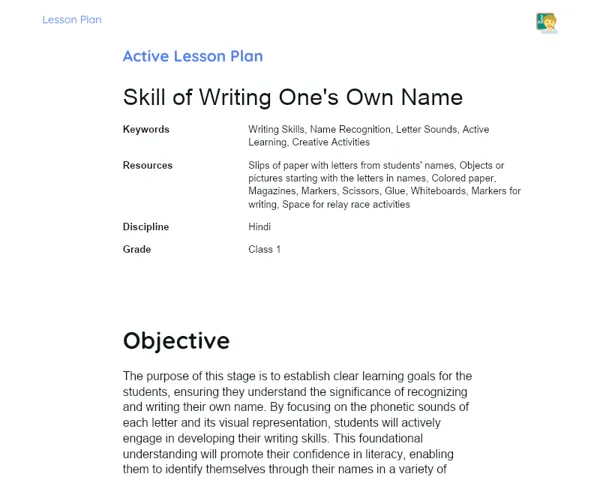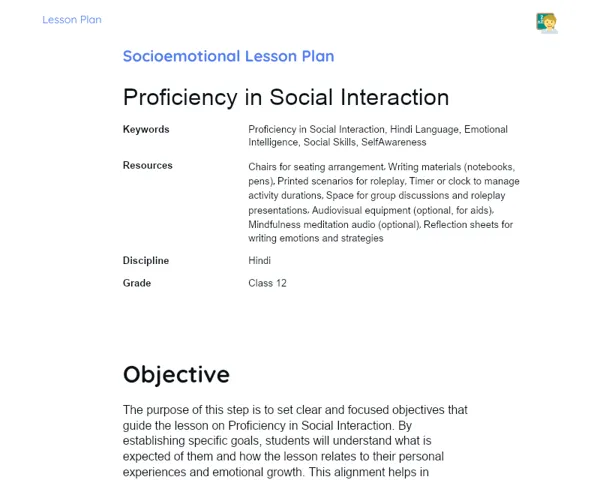Lesson Plan | Teachy's Iteractive Lesson Plan | Illustration and Description from Imagination
| Keywords | Imagination, Emotional Expression, Illustration, Descriptive Language, Creativity, Digital Art, Storytelling, Social Media, Collaboration, Peer Feedback, Engagement, Active Learning, Artistic Skills |
| Resources | Smartphones or tablets for online research, Digital illustration tools (e.g., Canva, Adobe Spark, Google Drawings, Procreate), Class-specific social media page (e.g., private Instagram or Facebook group), Computer/laptops for digital artwork compilation, Task cards for Emotion Quest, Art supplies (digital and traditional if required), Class website or e-portfolio for showcasing work, Projector or screen for presentations, Feedback sheets for peer reviews |
| Codes | - |
| Grade | Class 3 |
| Discipline | Hindi |
Objectives
Duration: 15 - 20 minutes
The purpose of this stage is to cultivate the students' imaginative skills, encouraging them to visualize and convey their feelings and ideas through creative illustrations and descriptive writing. By doing so, students learn to articulate their thoughts, fostering both emotional intelligence and creative expression, which are essential skills in today's world. This stage sets a foundation for deeper engagement with the topic, ensuring students are equipped and motivated to participate in the upcoming activities.
Main Objectives:
1. Develop the ability to express emotions and thoughts through imaginative illustrations and descriptive language.
2. Enhance creativity by connecting personal experiences with imaginative concepts in illustrations and descriptions.
Introduction
Duration: 15 - 20 minutes
The purpose of this introductory stage is to engage students actively in the topic by connecting it to their own experiences and the modern digital landscape. By utilizing their smartphones for research, students become active participants in the learning process, fostering a sense of curiosity and excitement about creativity. This initial exploration lays the groundwork for richer discussions and activities related to imaginative illustrations and descriptions, encouraging students to express their thoughts and emotions in unique ways.
Warming Up
To kick off this engaging lesson on "Illustration and Description from Imagination," the teacher will first encourage students to pull out their smartphones. Each student will spend a few minutes searching for an interesting fact related to art, emotions, or creative expression. This not only taps into their curiosity but also serves to bridge their personal experience with the upcoming activities. The teacher will then invite a few students to share their findings with the class, sparking an initial interest in how creativity connects with real-life emotions.
Initial Thoughts
1. What do you think is more important in storytelling: illustrations or descriptive words?
2. Can you think of a time when an illustration made you feel a certain emotion? How did it affect you?
3. How can we describe our feelings in a way that others can understand and visualize?
4. Why do you think imagination is a powerful tool in creating art or stories?
5. What emotions do you think are the hardest to illustrate? Why?
Development
Duration: 60 - 70 minutes
The purpose of this stage is to immerse students in a creative and engaging environment where they can enhance their imaginative skills while utilizing technology. Through collaborative activities that combine storytelling, digital creation, and emotional exploration, students will learn how to express their thoughts and feelings vividly. This stage not only fosters teamwork but also encourages meaningful discussions about emotions and the role of illustrations in storytelling.
Activity Suggestions
Activity Recommendations
Activity 1 - Emotion-Powered Storytelling through Social Media
> Duration: 60 - 70 minutes
- Goal: To empower students to express their emotions through storytelling and digital illustration, fostering creativity and emotional intelligence.
- Activity Description: In this activity, students will create a captivating short story based on an emotion they choose. They will illustrate this story using digital platforms such as Canva or Adobe Spark, incorporating visual elements that resonate with their chosen emotion. After creating their visual storytelling posts, students will share them on a class-specific social media page (like a private Instagram or Facebook group) where classmates can comment and engage with each other's work. This will not only enhance their creativity but also deepen their understanding of how illustrations can evoke emotions and convey messages.
- Instructions:
-
- Divide students into groups of up to 5 people.
-
- Each group selects an emotion (e.g., joy, sadness, anger, or surprise).
-
- Students brainstorm a short story that encapsulates their chosen emotion, making sure to include vivid descriptive language.
-
- Using digital tools such as Canva or Adobe Spark, groups illustrate their story creatively, ensuring their visuals complement the narrative.
-
- Once completed, each group posts their story on the class social media page.
-
- Groups will rotate commenting on each other's posts, providing constructive feedback and discussing the emotions illustrated.
-
- Finally, students present their stories and illustrations to the class, explaining their creative choices.
Activity 2 - Digital Art Gallery of Imagination
> Duration: 60 - 70 minutes
- Goal: To inspire creativity by having students visualize their thoughts and present them in a collaborative digital format, thereby enhancing their descriptive skills.
- Activity Description: In this innovative activity, students will create a 'digital gallery' of imaginative illustrations based on prompts provided by the teacher. Using online drawing tools such as Google Drawings or Procreate, students will visualize their thoughts and emotions based on the prompts and then compile their artwork into a cohesive digital gallery. This gallery will be displayed on a class website or e-portfolio, allowing parents and other students to appreciate their creative works.
- Instructions:
-
- Organize students into groups of 5.
-
- Each group receives a unique prompt (e.g., 'Imagine your dream world' or 'What does happiness look like?').
-
- Students collaborate to brainstorm and sketch their ideas digitally using tools like Google Drawings.
-
- Once sketches are finalized, students will create polished illustrations reflecting their interpretations of the prompt.
-
- Compile all illustrations into a digital format to create a gallery presentation.
-
- The teacher will guide students on how to upload their gallery to a designated class website.
-
- Host a virtual 'gallery walk' where students can explore each other's work and discuss the emotions behind their illustrations.
Activity 3 - Gamified Emotion Quest
> Duration: 60 - 70 minutes
- Goal: To engage students in a fun, competitive environment that encourages teamwork and creativity while expressing emotions through digital art.
- Activity Description: Students will embark on an 'Emotion Quest,' a gamified adventure where they will complete various tasks related to emotions and illustration. Each task will require producing a digital illustration or description that conveys a specific emotion, whether through comic strips, memes, or visual poetry. They will earn points for creativity, effort, and teamwork, with prizes for the top-performing group. The tasks will be structured to promote a deeper understanding of emotional expression through art.
- Instructions:
-
- Form groups of 5 students.
-
- The teacher introduces the Emotion Quest, explaining that each group will complete a series of creative tasks.
-
- Hand out task cards, each with a unique emotion and corresponding illustration requirement (e.g., 'Create a comic strip about fear').
-
- Students work collaboratively to complete the tasks, using drawing apps or platforms that suit their style.
-
- Once tasks are complete, groups present their illustrations to the class, explaining the emotions represented.
-
- Points are awarded based on creativity, teamwork, and quality of work.
-
- At the end of the activity, summarize findings and celebrate achievements with small prizes.
Feedback
Duration: 15 - 20 minutes
The purpose of this stage is to foster a collaborative learning environment where students can articulate their learning experiences and insights gained from the activities. By engaging in group discussions and peer feedback, students develop critical thinking and communication skills, enhancing their ability to reflect on their creative process. This stage encourages a sense of community and mutual respect, as students celebrate each other's achievements and learn from one another's perspectives.
Group Discussion
Let's take a moment to share what we have created today! Each group will have the opportunity to present their final illustrations and stories. Please describe what emotions you chose to illustrate, how your group collaborated, and what you learned about expressing feelings through art. Remember to listen carefully and respect each other's ideas as we celebrate our creativity together!
Reflections
1. How did your understanding of emotions change through the creative process today? 2. What challenges did you face while illustrating your chosen emotion, and how did you overcome them? 3. In what ways do you think your illustrations can help others understand your feelings?
360º Feedback
As a part of our constructive feedback session, each student will take turns sharing one positive comment and one suggestion for improvement with their group members. Remember to focus on the strengths of your peers' work and provide constructive advice that can help them grow in their creative journey. Let's support each other's artistic endeavors with respect and kindness!
Conclusion
Duration: 15 - 20 minutes
The purpose of this conclusion stage is to solidify and reflect on the learning experience, allowing students to appreciate the connections between their creativity and the world around them. By summarizing the key concepts and relating them to modern-day implications, students internalize their learning while recognizing the importance of emotional expression in their lives. This reflective moment not only enhances retention but also energizes students to continue exploring their creative potentials beyond the classroom. 🌟
Summary
🎉 And that’s a wrap on our creative journey! 🎉 Today, students dove into the magical realm of imagination, transforming emotions into vibrant illustrations and storytelling. They explored how feelings can be depicted visually, and how their creativity connects with their hearts! 🌈 Each group created enchanting stories that resonated with various emotions, enriching not only their understanding of art but also their capacity to convey personal experiences. Remember, when we blend imagination with emotion, we sprinkle a bit of life into our illustrations! ✨
World
In today's fast-paced world, creativity is not just a skill; it's a key to unlocking potential. Social media platforms buzz with stories that evoke emotions, and digital art is now a universal language. Our lesson reflected these dynamics, showing how emotional expression and illustrations shape narratives in contemporary society. Whether it's a meme that brings laughter or a digital artwork that sparks contemplation, the lessons learned today are relevant in expressing oneself in our modern, digitally-connected lives. 🌍
Applications
The ability to illustrate and describe emotions is essential in daily life, as it fosters communication and empathy. In various settings, from personal relationships to professional environments, being able to express thoughts and feelings through creative means can bridge gaps and create understanding. Whether reassuring a friend with a heartfelt note or channeling experiences into art, these skills enable students to connect deeper with their surroundings and navigate emotions effectively. 🎨💬


